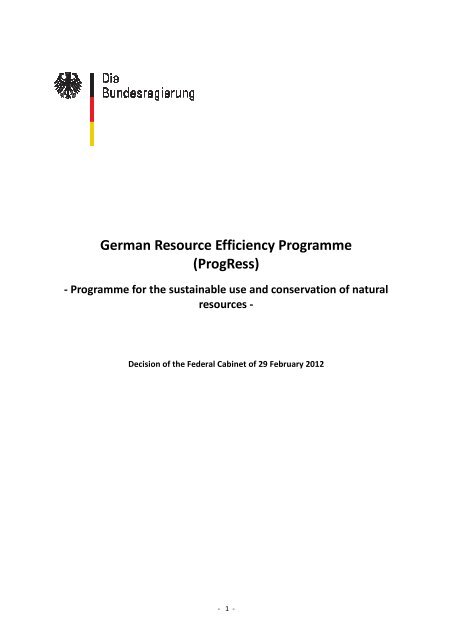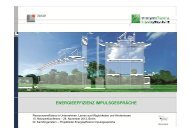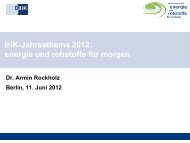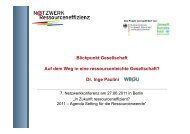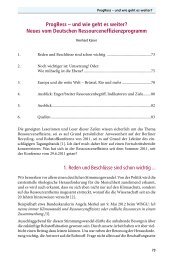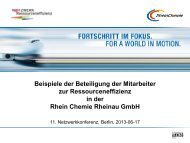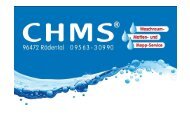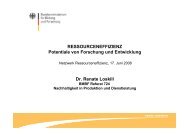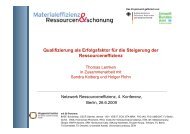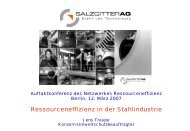German Resource Efficiency Programme (ProgRess)
German Resource Efficiency Programme (ProgRess)
German Resource Efficiency Programme (ProgRess)
Create successful ePaper yourself
Turn your PDF publications into a flip-book with our unique Google optimized e-Paper software.
<strong>German</strong> <strong>Resource</strong> <strong>Efficiency</strong> <strong>Programme</strong><br />
(<strong>ProgRess</strong>)<br />
- <strong>Programme</strong> for the sustainable use and conservation of natural<br />
resources -<br />
Decision of the Federal Cabinet of 29 February 2012<br />
- 1 -
Compiled pursuant to Cabinet decision of 20 October 2010 on the <strong>German</strong> Government's<br />
Raw Materials Strategy, based on the National Sustainability Strategy "Perspectives for<br />
<strong>German</strong>y" of 17 April 2002 and the “Thematic Strategy for the Sustainable Use of Natural<br />
<strong>Resource</strong>s” of the Commission of the European Union of 21 December 2005.<br />
Published by:<br />
Federal Ministry for the Environment, Nature Conservation and Nuclear Safety (BMU), Berlin<br />
11055 Berlin<br />
E-Mail: service@bmu.de, Internet: www.bmu.de<br />
Editors:<br />
Reinhard Kaiser (BMU, WA III), Anne Miehe, Birgit Schwenk (BMU, WA III 1)<br />
Cover: Pete Leonard / Corbis<br />
Taken from the VDI-ZRE campaign: www.das-zahlt-sich-aus.de<br />
As at:<br />
29 February 2012 Version 4.0.3<br />
- 2 -
Contents<br />
Preface<br />
Part I General Information on the <strong>Programme</strong><br />
1. <strong>Resource</strong> efficiency - challenge and opportunity<br />
1.1 Combining diverse activities: a programme for resource efficiency<br />
1.2 Focus of the programme: efficient management of raw materials<br />
1.3 Other resources and their uses<br />
• Water<br />
• Soil and land<br />
• Air<br />
• Biological diversity<br />
• Biotic raw materials as fuel or food and feedstuff<br />
2. Where do we stand?<br />
2.1 More growth, prosperity, quality of life - an increasing burden on the environment<br />
2.2 The economic potential of resource efficiency<br />
2.3 <strong>Resource</strong> conservation - an important task for policy-makers<br />
2.4 Current activities in <strong>German</strong>y - a wide range of initiatives<br />
3. Guiding principles and objectives<br />
3.1 Four guiding principles for the approach and angle taken<br />
• Joining ecological necessities with economic opportunities,<br />
innovation support and social responsibility.<br />
• Viewing global responsibility as a key focus of our national resource policy.<br />
• Gradually making economic and production practices in <strong>German</strong>y less dependent<br />
on primary resources, developing and expanding closed cycle management.<br />
• Securing sustainable resource use for the long term by guiding society towards<br />
quality growth.<br />
3.2 Indicators and objectives for decisions directed at efficiency<br />
• Inclusion of raw material equivalents of imports<br />
• Consideration of per capita domestic resource consumption<br />
• Mapping of unused material extraction<br />
• Contribution of closed cycle management: Consideration of cascade use and<br />
recycling<br />
- 3 -
Part II Strategic approaches along the entire value chain<br />
1. Securing a sustainable raw material supply<br />
Approach 1: Implementation and development of the Federal Government's Raw<br />
Materials Strategy<br />
Approach 2: Targeted expansion of the use of renewable resources as materials<br />
2. Raising resource efficiency in production<br />
Approach 3: Boosting innovation and competitiveness by strengthening efficiency<br />
advice for companies<br />
Approach 4: Development and dissemination of resource- and energy-efficient<br />
production and processing methods<br />
Approach 5: Information on and promotion of the use of environmental<br />
management systems<br />
Approach 6: Innovation through the integration of resource efficiency into product<br />
design<br />
Approach 7: Integration of resource conservation into standardisation<br />
3. Making consumption more resource-efficient<br />
Approach 8: Creating public awareness<br />
Approach 9: <strong>Resource</strong> efficiency as a criterion for trade and consumer decisions<br />
Approach 10: Introduction of new certification schemes, greater use of existing<br />
schemes for raw materials<br />
Approach 11: Increased use of public procurement as an instrument of resource<br />
efficiency<br />
4. Enhancing resource-efficient closed cycle management<br />
Approach 12: Reinforcing product responsibility<br />
Approach 13: Optimising collection and recycling of resource-relevant bulk wastes<br />
- 4 -
Approach 14: Ban on illegal exports, supporting waste recovery structures in newly<br />
industrialising and developing countries<br />
5. Using overarching instruments<br />
Approach 15: Strengthening instruments for improving market penetration of<br />
resource-efficient products and services<br />
Approach 16: Using economic instruments and dismantling subsidies which<br />
encourage resource consumption<br />
Approach 17: Strengthening research and improving the knowledge base<br />
Approach 18: Considering resource efficiency in the further development of the legal<br />
framework at national level<br />
Approach 19: Technology and knowledge transfer, expert advice<br />
Approach 20: Further developing the political and legal framework at EU level and in<br />
an international context<br />
Part III Specific examples<br />
1. Sectoral examples<br />
Example 1: Bulk metals<br />
Example 2: Rare earths and critical metals<br />
Example 3: Sustainable planning, construction and use of buildings and<br />
structures<br />
Example 4: <strong>Resource</strong> efficiency in future technologies - the example of<br />
photovoltaics<br />
Example 5: <strong>Resource</strong> efficiency in future technologies - the example of<br />
Electric mobility<br />
Example 6: Green IT: <strong>Resource</strong> efficiency in information and communication<br />
technology (ICT)<br />
Example 7: Renewable raw materials in the chemical industry<br />
2. Examples of material flows relevant to resource conservation<br />
Material flow 1: Phosphorous<br />
Material flow 2: Indium<br />
Material flow 3: Gold<br />
Material flow 4: Plastic waste<br />
- 5 -
IV. Annex<br />
1. Activities of the Federal Government<br />
2. Activities of the Länder<br />
3. Activities of associations and institutions<br />
- 6 -


